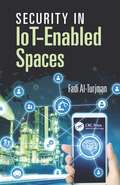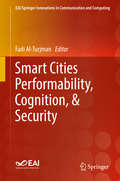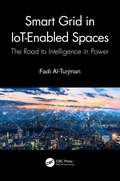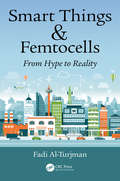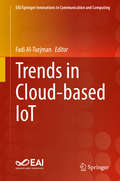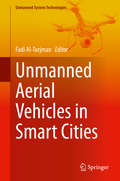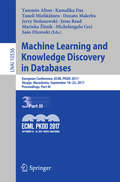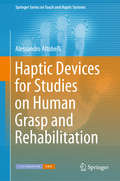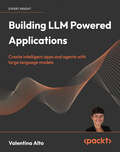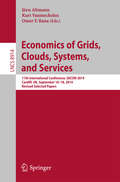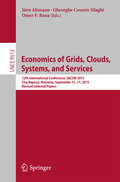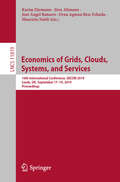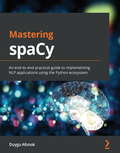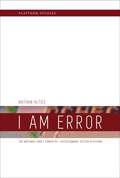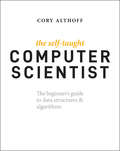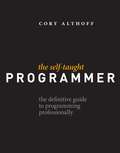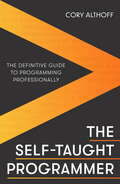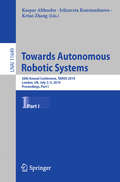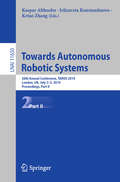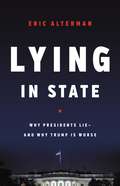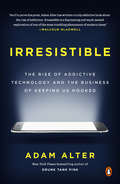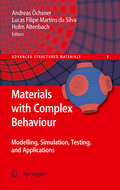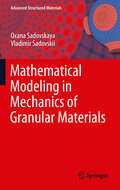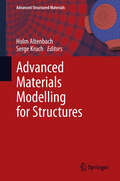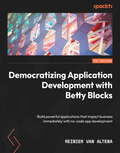- Table View
- List View
Security in IoT-Enabled Spaces
by Fadi Al-TurjmanSecurity and smart spaces are among the most significant topics in IoT nowadays. The implementation of secured smart spaces is at the heart of this concept, and its development is a key issue in the next generation IoT. This book addresses major security aspects and challenges in realizing smart spaces and sensing platforms in critical Cloud and IoT applications. The book focuses on both the design and implementation aspects of security models and strategies in smart that are enabled by wireless sensor networks and RFID systems. It mainly examines seamless data access approaches and encryption and decryption aspects in reliable IoT systems.
Smart Cities Performability, Cognition, & Security (EAI/Springer Innovations in Communication and Computing)
by Fadi Al-TurjmanThis book provides knowledge into the intelligence and security areas of smart-city paradigms. It focuses on connected computing devices, mechanical and digital machines, objects, and/or people that are provided with unique identifiers. The authors discuss the ability to transmit data over a wireless network without requiring human-to-human or human-to-computer interaction via secure/intelligent methods. The authors also provide a strong foundation for researchers to advance further in the assessment domain of these topics in the IoT era. The aim of this book is hence to focus on both the design and implementation aspects of the intelligence and security approaches in smart city applications that are enabled and supported by the IoT paradigms. Presents research related to cognitive computing and secured telecommunication paradigms;Discusses development of intelligent outdoor monitoring systems via wireless sensing technologies;With contributions from researchers, scientists, engineers and practitioners in telecommunication and smart cities.
Smart Grid in IoT-Enabled Spaces: The Road to Intelligence in Power
by Fadi Al-TurjmanInternet of Things (IoT)-enabled spaces have made revolutionary advances in the utility grid. Among these advances, intelligent and energy-efficient services are gaining considerable interest. The use of the smart grid is increasing day after day around us and is not only used in saving energy but also in our daily life for intelligent health, traffic, and even farming systems. The grid enabled with IoT features is also expected to communicate with cellular networks smoothly in the next-generation networks (6G and beyond). This will open the door for other interesting research areas. In this book, we consider the most significant and emergent research topics in this domain, addressing major issues and challenges in IoT-based solutions proposed for the smart grid. The chapters provide insight on comprehensive topics in IoT-based smart grids, combining technical aspects with the most up-to-date theory. It investigates the grid under varying and potential emerging paradigms such as edge/fog computing, in addition to big data aspects considerations in the IoT era. With comprehensive surveys and case studies, this book explores basic and high-level grid aspects in the emerging smart city paradigm, which makes it especially attractive to researchers, academics, and higher-level students. This authored book can be used by computer science undergraduate and postgraduate students, researchers and practitioners, city administrators, policymakers, and government regulators.
Smart Things and Femtocells: From Hype to Reality
by Fadi Al-TurjmanThis book provides a comprehensive overview for the use of femtocells in smart Internet of Things (IoT) environments. Femtocells will help mobile operators to provide a basis for the next generation of services which are a combination of voice, video, and data services to mobile users. This book discusses modelling traffic and deployment strategies in femtocells and provides a review for the use of femtocells and their applications in IoT environments. Moreover, it highlights the efficient real-time medium access, data delivery, caching and security aspects in smart spaces. It concludes by presenting open research issues associated with smart IoT-femtocell based applications.
Trends in Cloud-based IoT (EAI/Springer Innovations in Communication and Computing)
by Fadi Al-TurjmanThis book examines research topics in IoT and Cloud and Fog computing. The contributors address major issues and challenges in IoT-based solutions proposed for the Cloud. The authors discuss Cloud smart and energy efficient services in applications such as healthcare, traffic, and farming systems. Targeted readers are from varying disciplines who are interested in designing and deploying the Cloud applications. The book can be helpful to Cloud-based IoT service providers, Cloud-based IoT service consumers, and Cloud service developers in general for getting the state-of-the-art knowledge in the emerging IoT area. The book also provides a strong foundation for researchers to advance further in this domain. Presents a variety of research related to IoT and Cloud computing; Provides the industry with new and innovative operational ideas; Pertinent to academics, researchers, and practitioners around the world.
Unmanned Aerial Vehicles in Smart Cities (Unmanned System Technologies)
by Fadi Al-TurjmanThis book addresses the major challenges in realizing unmanned aerial vehicles (UAVs) in IoT-based Smart Cities. The challenges tackled vary from cost and energy efficiency to availability and service quality. The aim of this book is to focus on both the design and implementation aspects of the UAV-based approaches in IoT-enabled smart cities’ applications that are enabled and supported by wireless sensor networks, 5G, and beyond. The contributors mainly focus on data delivery approaches and their performability aspects. This book is meant for readers of varying disciplines who are interested in implementing the smart planet/environments vision via wireless/wired enabling technologies.Involves the most up to date unmanned aerial vehicles (UAV) assessment and evaluation approachesIncludes innovative operational ideas in agriculture, surveillance, rescue, etc.Pertains researchers, scientists, engineers and practitioners in the field of smart cities, IoT, and communicationsFadi Al-Turjman received his Ph.D. from Queen’s University, Canada. He is a full professor and a research center director at Near East University, Nicosia. He is a leading authority in the area of IoT and intelligent systems. His publication history spans over 250 publications in addition to his editorialship in top journals such as the IEEE Communication Surveys and Tutorials, and the Elsevier Sustaibable Cities and Society.
Machine Learning and Knowledge Discovery in Databases
by Yasemin Altun Kamalika Das Taneli Mielikäinen Donato Malerba Jerzy Stefanowski Jesse Read Marinka Žitnik Michelangelo Ceci Sašo DžeroskiThis three-volume set LNAI 6911, LNAI 6912, and LNAI 6913 constitutes the refereed proceedings of the European conference on Machine Learning and Knowledge Discovery in Databases: ECML PKDD 2011, held in Athens, Greece, in September 2011. The 121 revised full papers presented together with 10 invited talks and 11 demos in the three volumes, were carefully reviewed and selected from about 600 paper submissions. The papers address all areas related to machine learning and knowledge discovery in databases as well as other innovative application domains such as supervised and unsupervised learning with some innovative contributions in fundamental issues; dimensionality reduction, distance and similarity learning, model learning and matrix/tensor analysis; graph mining, graphical models, hidden markov models, kernel methods, active and ensemble learning, semi-supervised and transductive learning, mining sparse representations, model learning, inductive logic programming, and statistical learning. a significant part of the papers covers novel and timely applications of data mining and machine learning in industrial domains.
Haptic Devices for Studies on Human Grasp and Rehabilitation
by Alessandro AltobelliThis book presents a new set of devices for accurate investigation of human finger stiffness and force distribution in grasping tasks. The ambitious goal of this research is twofold, the first is to advance the state of the art on human strategies in manipulation tasks and provide tools to assess rehabilitation procedure and the second is to investigate human strategies for impedance control that can be used for human robot interaction and control of myoelectric prosthesis. Part one describes two types of systems that are able to achieve a complete set of measurements on force distribution and contact point locations. The effectiveness of these devices in grasp analysis is also experimentally demonstrated and applications to neuroscientific studies are discussed. In part two, the devices are exploited in two different studies to investigate stiffness regulation principles in humans. The first study provides evidence on the existence of coordinated stiffening patterns in the fingers of human hands and establishes initial steps towards a real-time and effective modelling of finger stiffness in tripod grasp. The second study presents experimental findings on how humans modulate their hand stiffness whilst grasping objects of varying levels of compliance. The overall results give solid evidence on the validity and utility of the proposed devices to investigate human grasp properties. The underlying motor control principles that are exploited by humans in the achievement of a reliable and robust grasp can potentially be integrated into the control framework of robotic or prosthetic hands to achieve a similar interaction performance.
Building LLM Powered Applications: Create intelligent apps and agents with large language models
by Valentina AltoGet hands-on with GPT 3.5, GPT 4, LangChain, Llama 2, Falcon LLM and more, to build LLM-powered sophisticated AI applicationsKey FeaturesEmbed LLMs into real-world applicationsUse LangChain to orchestrate LLMs and their components within applicationsGrasp basic and advanced techniques of prompt engineeringBook DescriptionBuilding LLM Powered Applications delves into the fundamental concepts, cutting-edge technologies, and practical applications that LLMs offer, ultimately paving the way for the emergence of large foundation models (LFMs) that extend the boundaries of AI capabilities. The book begins with an in-depth introduction to LLMs. We then explore various mainstream architectural frameworks, including both proprietary models (GPT 3.5/4) and open-source models (Falcon LLM), and analyze their unique strengths and differences. Moving ahead, with a focus on the Python-based, lightweight framework called LangChain, we guide you through the process of creating intelligent agents capable of retrieving information from unstructured data and engaging with structured data using LLMs and powerful toolkits. Furthermore, the book ventures into the realm of LFMs, which transcend language modeling to encompass various AI tasks and modalities, such as vision and audio. Whether you are a seasoned AI expert or a newcomer to the field, this book is your roadmap to unlock the full potential of LLMs and forge a new era of intelligent machines.What you will learnExplore the core components of LLM architecture, including encoder-decoder blocks and embeddingsUnderstand the unique features of LLMs like GPT-3.5/4, Llama 2, and Falcon LLMUse AI orchestrators like LangChain, with Streamlit for the frontendGet familiar with LLM components such as memory, prompts, and toolsLearn how to use non-parametric knowledge and vector databasesUnderstand the implications of LFMs for AI research and industry applicationsCustomize your LLMs with fine tuningLearn about the ethical implications of LLM-powered applicationsWho this book is for Software engineers and data scientists who want hands-on guidance for applying LLMs to build applications. The book will also appeal to technical leaders, students, and researchers interested in applied LLM topics. We don’t assume previous experience with LLM specifically. But readers should have core ML/software engineering fundamentals to understand and apply the content.
Economics of Grids, Clouds, Systems, and Services
by Jörn Altmann Kurt Vanmechelen Omer F. RanaThis book constitutes the refereed proceedings of the 11th International Conference on Economics of Grids, Clouds, Systems, and Services, GECON 2014, held in Cardiff, UK, in September 2014. The 8 revised full papers and 7 paper-in-progress presented were carefully reviewed and selected from 24 submissions. The presentation sessions that have been set up are: Cloud Adoption, Work in Progress on Market Dynamics, Cost Optimization, Work in Progress on Pricing, Contracts and Service Selection and Economic Aspects of Quality of Service.
Economics of Grids, Clouds, Systems, and Services
by Jörn Altmann Gheorghe Cosmin Silaghi Omer F. RanaThis book constitutes the refereed proceedings of the 12th International Conference on Economics of Grids, Clouds, Systems, and Services, GECON 2015, held in Cluj-Napoca, Romania, in September 2015. The 11 revised full papers and 10 paper-in-progress presented were carefully reviewed and selected from 38 submissions. The presentation sessions that have been set up are: resource allocation, service selection in clouds, energy conservation and smart grids, applications: tools and protocols, community networks and legal and socio-economic aspects.
Economics of Grids, Clouds, Systems, and Services: 16th International Conference, GECON 2019, Leeds, UK, September 17–19, 2019, Proceedings (Lecture Notes in Computer Science #11819)
by Jörn Altmann José Ángel Bañares Maurizio Naldi Karim Djemame Orna Agmon Ben-YehudaThis book constitutes the refereed proceedings of the 16th International Conference on Economics of Grids, Clouds, Systems, and Services, GECON 2019, held in Leeds, UK, in September 2019. The 12 full papers and 10 short papers presented in this book were carefully reviewed and selected from 48 submissions. This GECON 2019 proceedings was structured in selected topics, namely: blockchain technology and smart contracts; cost-based computing allocation; resource, service and communication federations; economic assessment, business and pricing models; blockchain and network function virtualization technologies; economic models for cyber-physical systems, industry 4.0 and sustainable systems; resource management; and emerging ideas.
Mastering spaCy: An end-to-end practical guide to implementing NLP applications using the Python ecosystem
by Duygu AltinokBuild end-to-end industrial-strength NLP models using advanced morphological and syntactic features in spaCy to create real-world applications with easeKey FeaturesGain an overview of what spaCy offers for natural language processingLearn details of spaCy's features and how to use them effectivelyWork through practical recipes using spaCyBook DescriptionspaCy is an industrial-grade, efficient NLP Python library. It offers various pre-trained models and ready-to-use features. Mastering spaCy provides you with end-to-end coverage of spaCy's features and real-world applications. You'll begin by installing spaCy and downloading models, before progressing to spaCy's features and prototyping real-world NLP apps. Next, you'll get familiar with visualizing with spaCy's popular visualizer displaCy. The book also equips you with practical illustrations for pattern matching and helps you advance into the world of semantics with word vectors. Statistical information extraction methods are also explained in detail. Later, you'll cover an interactive business case study that shows you how to combine all spaCy features for creating a real-world NLP pipeline. You'll implement ML models such as sentiment analysis, intent recognition, and context resolution. The book further focuses on classification with popular frameworks such as TensorFlow's Keras API together with spaCy. You'll cover popular topics, including intent classification and sentiment analysis, and use them on popular datasets and interpret the classification results. By the end of this book, you'll be able to confidently use spaCy, including its linguistic features, word vectors, and classifiers, to create your own NLP apps.What you will learnInstall spaCy, get started easily, and write your first Python scriptUnderstand core linguistic operations of spaCyDiscover how to combine rule-based components with spaCy statistical modelsBecome well-versed with named entity and keyword extractionBuild your own ML pipelines using spaCyApply all the knowledge you've gained to design a chatbot using spaCyWho this book is forThis book is for data scientists and machine learners who want to excel in NLP as well as NLP developers who want to master spaCy and build applications with it. Language and speech professionals who want to get hands-on with Python and spaCy and software developers who want to quickly prototype applications with spaCy will also find this book helpful. Beginner-level knowledge of the Python programming language is required to get the most out of this book. A beginner-level understanding of linguistics such as parsing, POS tags, and semantic similarity will also be useful.
I Am Error: The Nintendo Family Computer / Entertainment System Platform
by Nathan AlticeIn the 1987 Nintendo Entertainment System videogame Zelda II: The Adventure of Link, a character famously declared: I AM ERROR. Puzzled players assumed that this cryptic mesage was a programming flaw, but it was actually a clumsy Japanese-English translation of "My Name is Error," a benign programmer's joke. In I AM ERROR Nathan Altice explores the complex material histories of the Nintendo Entertainment System (and its Japanese predecessor, the Family Computer), offering a detailed analysis of its programming and engineering, its expressive affordances, and its cultural significance. Nintendo games were rife with mistranslated texts, but, as Altice explains, Nintendo's translation challenges were not just linguistic but also material, with consequences beyond simple misinterpretation. Emphasizing the technical and material evolution of Nintendo's first cartridge-based platform, Altice describes the development of the Family Computer (or Famicom) and its computational architecture; the "translation" problems faced while adapting the Famicom for the U. S. videogame market as the redesigned Entertainment System; Nintendo's breakthrough console title Super Mario Bros. and its remarkable software innovations; the introduction of Nintendo's short-lived proprietary disk format and the design repercussions on The Legend of Zelda; Nintendo's efforts to extend their console's lifespan through cartridge augmentations; the Famicom's Audio Processing Unit (APU) and its importance for the chiptunes genre; and the emergence of software emulators and the new kinds of play they enabled.
The Self-Taught Computer Scientist: The Beginner's Guide to Data Structures & Algorithms
by Cory AlthoffThe Self-Taught Computer Scientist is Cory Althoff's follow-up to The Self-Taught Programmer, which inspired hundreds of thousands of professionals to learn how to program outside of school. In The Self-Taught Programmer, Cory showed readers why you don't need a computer science degree to program professionally and taught the programming fundamentals he used to go from a complete beginner to a software engineer at eBay without one. In The Self-Taught Computer Scientist, Cory teaches you the computer science concepts that all self-taught programmers should understand to have outstanding careers. The Self-Taught Computer Scientist will not only make you a better programmer; it will also help you pass your technical interview: the interview all programmers have to pass to land a new job. Whether you are preparing to apply for jobs or sharpen your computer science knowledge, reading The Self-Taught Computer Scientist will improve your programming career. It's written for complete beginners, so you should have no problem reading it even if you've never studied computer science before.
The Self-Taught Programmer: The Definitive Guide to Programming Professionally, 1st Edition
by Cory AlthoffI am a self-taught programmer. After a year of self-study, I learned to program well enough to land a job as a software engineer II at eBay. Once I got there, I realized I was severely under-prepared. I was overwhelmed by the amount of things I needed to know but hadn't learned yet. My journey learning to program, and my experience at my first job as a software engineer were the inspiration for this book. <P><P>This book is not just about learning to program; although you will learn to code. If you want to program professionally, it is not enough to learn to code; that is why, in addition to helping you learn to program, I also cover the rest of the things you need to know to program professionally that classes and books don't teach you. "The Self-taught Programmer" is a roadmap, a guide to take you from writing your first Python program, to passing your first technical interview. I divided the book into five sections: <P><P> 1. Learn to program in Python 3 and build your first program. </br> 2. Learn Object-oriented programming and create a powerful Python program to get you hooked. </br> 3. Learn to use tools like Git, Bash, regular expressions and databases. Then use your new coding skills to build a web scraper. </br> 4. Study Computer Science fundamentals like data structures and algorithms.</br> 5. Finish with tips for working with a team and landing a programming job. <P><P>You CAN learn to program professionally. The path is there. Will you take it?
The Self-taught Programmer: The Definitive Guide to Programming Professionally
by Cory Althoff'One of the best software design books of all time' - BookAuthorityCory Althoff is a self-taught programmer. After a year of self-study, he learned to program well enough to land a job as a software engineer II at eBay. But once he got there, he realised he was severely under-prepared. He was overwhelmed by the amount of things he needed to know but hadn't learned. His journey learning to program, and his experience in first software engineering job were the inspiration for this book. This book is not just about learning to program, although you will learn to code. If you want to program professionally, it is not enough to learn to code; that is why, in addition to helping you learn to program, Althoff also cover the rest of the things you need to know to program professionally that classes and books don't teach you. The Self-taught Programmer is a roadmap, a guide to take you from writing your first Python program to passing your first technical interview. The book is divided into five sections: 1. Learn to program in Python 3 and build your first program. 2. Learn object-oriented programming and create a powerful Python program to get you hooked. 3. Learn to use tools like Git, Bash and regular expressions. Then use your new coding skills to build a web scraper. 4. Study computer science fundamentals like data structures and algorithms. 5. Finish with best coding practices, tips for working with a team and advice on landing a programming job.You can learn to program professionally. The path is there. Will you take it?From the authorI spent one year writing The Self-Taught Programmer. It was an exciting and rewarding experience. I treated my book like a software project. After I finished writing it, I created a program to pick out all of the code examples from the book and execute them in Python to make sure all 300+ examples worked properly. Then I wrote software to add line numbers and color to every code example. Finally, I had a group of 200 new programmers 'beta read' the book to identify poorly explained concepts and look for any errors my program missed. I hope you learn as much reading my book as I did writing it. Best of luck with your programming!
Towards Autonomous Robotic Systems: 20th Annual Conference, TAROS 2019, London, UK, July 3–5, 2019, Proceedings, Part I (Lecture Notes in Computer Science #11649)
by Kaspar Althoefer Jelizaveta Konstantinova Ketao ZhangThe two volumes LNAI 11649 and LNAI 11650 constitute the refereed proceedings of the 20th Annual Conference "Towards Autonomous Robotics", TAROS 2019, held in London, UK, in July 2019.The 74 full papers and 12 short papers presented were carefully reviewed and selected from 101 submissions. The papers present and discuss significant findings and advances in autonomous robotics research and applications. They are organized in the following topical sections: robotic grippers and manipulation; soft robotics, sensing and mobile robots; robotic learning, mapping and planning; human-robot interaction; and robotic systems and applications.
Towards Autonomous Robotic Systems: 20th Annual Conference, TAROS 2019, London, UK, July 3–5, 2019, Proceedings, Part II (Lecture Notes in Computer Science #11650)
by Kaspar Althoefer Jelizaveta Konstantinova Ketao ZhangThe two volumes LNAI 11649 and 11650 constitute the refereed proceedings of the 20th Annual Conference "Towards Autonomous Robotics", TAROS 2019, held in London, UK, in July 2019.The 87 full papers and 12 short papers presented were carefully reviewed and selected from 101 submissions. The papers present and discuss significant findings and advances in autonomous robotics research and applications. They are organized in the following topical sections: robotic grippers and manipulation; soft robotics, sensing and mobile robots; robotic learning, mapping and planning; human-robot interaction; and robotic systems and applications.
Lying in State: Why Presidents Lie -- And Why Trump Is Worse
by Eric AltermanThis definitive history of presidential lying reveals how our standards for truthfulness have eroded -- and why Trump's lies are especially dangerous.If there's one thing we know about Donald Trump, it's that he lies. But he's by no means the first president to do so. In Lying in State, Eric Alterman asks how we ended up with such a pathologically dishonest commander in chief, showing that, from early on, the United States has persistently expanded its power and hegemony on the basis of presidential lies. He also reveals the cumulative effect of this deception-each lie a president tells makes it more acceptable for subsequent presidents to lie-and the media's complicity in spreading misinformation. Donald Trump, then, represents not an aberration but the culmination of an age-old trend. Full of vivid historical examples and trenchant analysis, Lying in State is essential reading for anyone seeking to understand how we arrived in this age of alternative facts.
Irresistible: The Rise Of Addictive Technology And The Business Of Keeping Us Hooked
by Adam AlterWelcome to the age of behavioral addiction—an age in which half of the American population is addicted to at least one behavior. We obsess over our emails, Instagram likes, and Facebook feeds; we binge on TV episodes and YouTube videos; we work longer hours each year; and we spend an average of three hours each day using our smartphones. Half of us would rather suffer a broken bone than a broken phone, and Millennial kids spend so much time in front of screens that they struggle to interact with real, live humans. In this revolutionary book, Adam Alter, a professor of psychology and marketing at NYU, tracks the rise of behavioral addiction, and explains why so many of today's products are irresistible. Though these miraculous products melt the miles that separate people across the globe, their extraordinary and sometimes damaging magnetism is no accident. The companies that design these products tweak them over time until they become almost impossible to resist. By reverse engineering behavioral addiction, Alter explains how we can harness addictive products for the good—to improve how we communicate with each other, spend and save our money, and set boundaries between work and play—and how we can mitigate their most damaging effects on our well-being, and the health and happiness of our children.Adam Alter's previous book, Drunk Tank Pink: And Other Unexpected Forces that Shape How We Think, Feel, and Behave is available in paperback from Penguin.
Materials with Complex Behaviour
by Holm Altenbach Lucas F. SilvaThe increasing demand for materials with superb properties in all types of technical applications requires the development of advanced materials and respective tools to characterise and predict the material properties and behaviour. This monograph highlights the latest developments and trends in advanced materials and their properties, the modelling and simulation of non-classical materials and structures, and new technologies for joining materials.
Mathematical Modeling in Mechanics of Granular Materials
by Holm Altenbach Oxana Sadovskaya Vladimir SadovskiiThis monograph contains original results in the field of mathematical and numerical modeling of mechanical behavior of granular materials and materials with different strengths. It proposes new models helping to define zones of the strain localization. The book shows how to analyze processes of the propagation of elastic and elastic-plastic waves in loosened materials, and constructs models of mixed type, describing the flow of granular materials in the presence of quasi-static deformation zones. In a last part, the book studies a numerical realization of the models on multiprocessor computer systems. The book is intended for scientific researchers, lecturers of universities, post-graduates and senior students, who specialize in the field of the deformable materials mechanics, mathematical modeling and adjacent fields of applied and calculus mathematics.
Advanced Materials Modelling for Structures: With Multi-scale Effects Or Under Multi-field Actions (Advanced Structured Materials #19)
by Holm Altenbach Serge KruchThis volume presents the major outcome of the IUTAM symposium on "Advanced Materials Modeling for Structures". It discusses advances in high temperature materials research, and also to provides a discussion the new horizon of this fundamental field of applied mechanics. The topics cover a large domain of research but place a particular emphasis on multiscale approaches at several length scales applied to non linear and heterogeneous materials. Discussions of new approaches are emphasised from various related disciplines, including metal physics, micromechanics, mathematical and computational mechanics.
Democratizing Application Development with Betty Blocks: Build powerful applications that impact business immediately with no-code app development
by Reinier van AltenaCreate applications efficiently with the help of comprehensive insights into the Betty Blocks no-code platform using this hands-on guidePurchase of the print or Kindle book includes a free PDF eBookKey FeaturesUnderstand the different capabilities, features, and low-code functionalities of Betty Blocks with real-world use casesExplore applications that impact your business right away with rapid application developmentDevelop dynamic web applications with easy drag-and-drop functionalities from Betty BlocksBook DescriptionThis practical guide on no-code development with Betty Blocks will take you through the different features, no-code functionalities, and capabilities of the Betty Blocks platform using real-world use cases. The book will equip you with the tools to develop business apps based on various data models, business processes, and more.You'll begin with an introduction to the basic concepts of the Betty Blocks no-code platform, such as developing IT solutions on various use cases including reporting apps, data tracking apps, workflows, and business processes. After getting to grips with the basics, you'll explore advanced concepts such as building powerful applications that impact the business straight away with no-code application development and quickly creating prototypes. The concluding chapters will help you get a solid understanding of rapid application development, building customer portals, building dynamic web apps, drag-and-drop front ends, visual modelling capabilities, and complex data models.By the end of this book, you'll have gained a comprehensive understanding of building your own applications as a citizen developer using the Betty Blocks no-code platform.What you will learnUnderstand what you can achieve with citizen developmentFind out how to build your first application with no-code developmentGet to grips with the basics of the Betty Blocks platform as a citizen developerDiscover how to build your own application or prototypeBuild business applications based on data models and business processesEnable developers to include additional functionality for citizen developersWho this book is forThis book is for citizen developers and business users who want to build applications to fulfill their business needs without depending on developers. Prior knowledge of coding and application development is not necessary, but it will speed up your learning.
